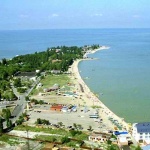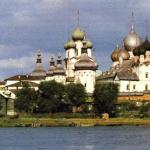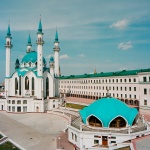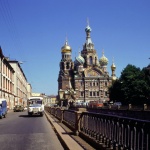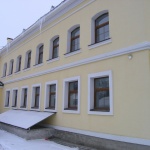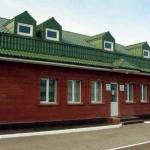Russia Traditional cuisine
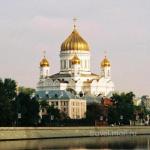 Russian feast has long been renowned for its hospitality. Famous cook of the nineteenth century B. Levshin said: "Establishment of the Russian table consisted of four feeds: cold meats, hot or soup, and fried, stewed fruit and cake." Typically, at the beginning of a feast is served "vstupitelnye" snacks. They are salted, fermented and pickled fruits, vegetables, mushrooms.
Russian feast has long been renowned for its hospitality. Famous cook of the nineteenth century B. Levshin said: "Establishment of the Russian table consisted of four feeds: cold meats, hot or soup, and fried, stewed fruit and cake." Typically, at the beginning of a feast is served "vstupitelnye" snacks. They are salted, fermented and pickled fruits, vegetables, mushrooms.Until the XVIII century Russia was the main food of turnip. She ate boiled, broiled, steamed, added to soup, kvass, filling for pies, stuffed. Have become part of everyday life kryukva, radish, cabbage. Snacks beet appeared first in the central and southern parts of the country, and then spread to the northern region.
Very long in Russia ate the cabbage. The first official mention of it in the chronicle in XII century. In 1150 the chronicler made a record that "Prince Rostislav of Smolensk Mstislavovich gave Bishop Manuel garden with Kapustnyak." Ancient Slavs borrowed this culture from the Greco-Roman colonists of the Crimea.
Gradually cabbage moved to the north, were selected its class, the most suitable for the harsh climatic conditions. Slavs invented booze cabbage - an original way prigotovlneniya and preserve for future use of valuable vegetable. They are learned fermented Germans and other peoples. Initially, cabbage was the only privilege of the nobility. It has long been used to bake pies with cabbage, shredded and salted, stewed, boiled from her soup and cook for a further set of dishes.
At the end of the beginning of the XVII-XVIII century revolution in Russian cuisine made potato. Dishes were ousted from the products of turnip, swede. It is believed that the potato came to Russia in Kamchatka, Siberia, the Urals. No coincidence that in these areas so common potato dishes.
Important role played by fungi, because Russia's forests are rich in mushrooms, honey agarics, chanterelles, mushrooms, ryazhikami, edible boletus, odosinovikami. Mushrooms - of great help home table, they are useful and delicious. We loved to Russia fruit, but used to call them vegetables. Already in the XVI century, mentions apples, pears and plums, used for Kvasov, "lavashnikov. Then there is a pumpkin, zucchini salad. Later, all come to us tomatoes - in the XIX century. No kitchen can not boast such a variety of first courses. In order to be better fed to them by tradition served pastry: pies, tarts, pies, pie. Favorite first course of the Russian people are rightly considered soup. Their advantages in prostoste prigotolveniya, nutritional value and pleasant taste. If the soup - a favorite dish in the middle zone of Russia, then in the central and southern areas are popular borscht. This is due to the fact that the southern lands brought a rich harvest of beets.
The word "soup" appearing under Peter I, before all the liquid called soup dishes, sometimes yushkami - from the word "ear", which refers to the first dish with noodles, cereals, vegetables. Soups served in a pot or cast iron. They ate nothing but wooden spoons.
The peculiarity of Russian cuisine is largely due to the peculiarities of processing products in the Russian stove. Until the middle of XIX century, the furnace was "black", until it appeared the chimney. Since its construction related and form of Russian dishes, ceramic first, and then the iron and iron. Slavic pots made on a potter's wheel, have a greater lateral surface, as poldogrev in the furnace goes on the sides. Low ploschadt bottom of a well-regulated thermal regime, and the narrow orlovina reduces evaporation and retains volatile properties. In Russia znachli and other types of hearth: open fire, tripod, spit.
The first plates came under Peter 1 as zaimstovannye of German cuisine, and with them, and pots, pans, baking trays. But the Russian Pes has not disappeared. Because sovey universality (in her baked bread, cooked kvass, dried food and clothes, it otaplivadi room), she firmly established in the life of the people. Yes, and dishes from the oven has a unique taste. List of Russian dishes would be incomplete without cereals. "Kasha-our mother" - so say the people-tiller of dishes prigotolvennyh of grains, cereals, which were perpetually an object of worship and a symbol of household welfare. Kashi were inapplicable attribute in epics and fairy tales. Even the wedding feast was called in olden porridge. In the baking of the most typical of Russian Cooney use dough. Some pastry necessarily in traditional ceremonies and festivals. None of the solemn event in the family is not complete without cake, pie or gingerbread. At the wedding baked kurnik, Pancake Day - pancakes and pies. On Christmas baking Christmas carols - small pastries, rye unleavened dough with various fillings, liqueurs, namazkami or the heat of the sun. Spring meets smart "larks". In the northern areas of New Year holidays invariably accompanied by "goat" and "hen" honored the vernal equinox. Guest was greeted loaf and salt. Karavay placed in the center of the table on any feast.
Rich Russian food and drinks, brewed in herbs and berries. Tea appeared in Russia only in the XVII century, and before that enjoyed great popularity and sbiten razlinchye mead and jelly.
